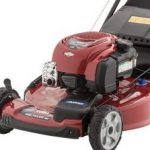Now that you know what scarifying is and when to do it, you are now ready to actually perform the task.
As explained earlier, you can perform the process manually using a rake. It is advised that if you are using a hand-held rake you should wear leather gloves with talcum powder in them to avoid blisters.
You may think that you need to apply a lot of pressure when raking. Actually, it is advised to offer moderate pressure. In addition, rake repeatedly to lift out the moss or thatch.
Although raking may not be as intense as you thought it would be, it is still a lot easier to use a lawn scarifier that has wheels. Less work is involved and it offers a gentle teasing action that is just as effective as raking.
If you do rake, it is advised that you perform the process once in one direction and again at a slightly different angle. It is advised that you don’t approach the second go around at right angles because it can cause too much damage.
Once done, use your mower or a landscapers rake to gather up the debris.
If you are more inclined to use an electric rake, then it is suggested that you repeat runs up and down the lawn to “tease” the moss or thatch out of the grass.
There are gasoline-powered scarifiers you can use. However, if you choose to use this option, take care. The machine has a lot of power to go deep into the soil. Don’t let it. Instead, you should tease the moss or thatch out with gradual deeper runs.
Most of these machines have a height adjustment. Set it while on a hard surface so that the blades or wires just touch the ground and do it with the motor off. Start doing a few meters on the lawn and make minor adjustments to remove debris without causing great chunks of grass to come up.
Use a large 2-foot to 3-foot wide landscaper or hay rake or the mower to collect the debris. Many who have performed this task suggest using the mower because it helps to pack the debris better.
There is a possibility that the moss or thatch debris is bad. If so, perform the collection regularly as you proceed with the scarifying to assure that the lawn is clear for the next run.
Change directions on the second run. It helps in removing more moss or thatch and helps you to finish the job sooner.
As you continue with the task less debris will remain. So you can lower the machine for each new run. If you are using a scarifier with blades, allow it to penetrate the soil up to ¼-inch. This will allow good seeding if you intend to also do some over seeding after the scarifying is finished.
If you are using an electric lawn rake or wire tines to scarify keep them off the soil because they can cause a lot of damage.
If the moss or thatch is not particularly bad or you perform the scarifying in the spring, then two runs — one up and down and one across — should be sufficient. However, it the moss or thatch problem is bad and conditions are good, then four or five runs may be necessary.
The results of scarifying will scare you. However, with a little help the lawn will come back better than ever.
Bumps in the lawn can present a problem. Scarifying over them can cause damage even if you are raking or scarifying gently. The damage can be fixed in the recovery process.
One way to remedy the issue of bumps is to top dress the area 3 to 4 kilos per square meter after scarifying.
If the thatch on your lawn is really bad, then it is possible that it may root into the grass. If this occurs, you will see large lumps of lawn get pulled away or you end up with thatch and no grass. One of two things could be why this occurs. Either the lawn has been neglected or the soil is too compact and there is disease present. If it is compaction of soil and disease, then it is suggested that you consider a new lawn. If the cause is neglect, then keep scarifying until you get down to the soil. The odds are under this situation you will remove a lot of living grass. Should this occur, you will have to re-seed the lawn.
(Next time: What to do after scarifying)







